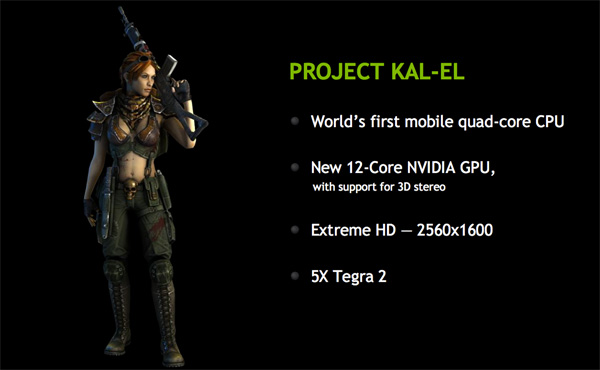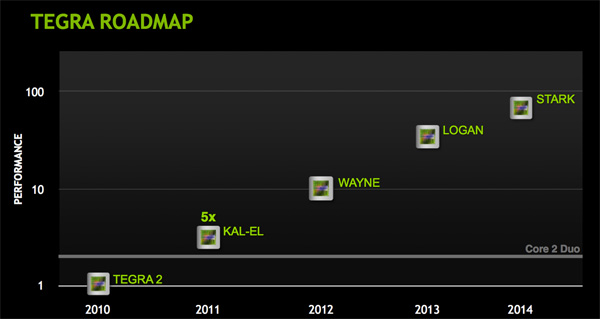NVIDIA's Project Kal-El: Quad-Core A9s Coming to Smartphones/Tablets This Year
by Anand Lal Shimpi on February 15, 2011 9:05 PM ESTIf there's any one takeaway from both CES and Mobile World Congress this year it's that NVIDIA is unequivocally a player in the SoC space. With design wins from LG, Motorola and Samsung, NVIDIA may not have the entire market but it has enough of it to be taken seriously.
In our Optimus 2X Review I mentioned that it looked like NVIDIA was going to be moving to a 6-month product cycle in the SoC space. The intention is to out execute its competitors frequently enough that they are either forced out of the market or into making a mistake trying to keep up. It's the same strategy that NVIDIA used to compete with 3dfx almost fifteen years ago.
I wrote that in 2011 NVIDIA would release Tegra 2 followed by the Tegra 2 3D (a higher clocked version of the Tegra 2 with support for 3D content) and finally the Tegra 3 before the end of the year. While it wasn't too long ago that NVIDIA was telling people about its 6-month product cycle, things have changed.
The Tegra 2 3D looks like it's not going to happen. The higher clocked SoC is not currently in any designs that are in the pipeline. There are Tegra 2 based smartphones and tablets that are due out this year, but nothing based on T25/AP25 as far as I can tell.
Although the middle of the roadmap changed, it's the end of 2011 that's sort of amazing. Internally NVIDIA referred to this chip as Tegra 3, and externally we expected it at the tail end of 2011 with devices launching in Q1 2012.
NVIDIA got the first silicon back from the fab 12 days ago. While the chip may end up being called Tegra 3 or some variation of that, for now NVIDIA refers to it as Project Kal-El. Named after young superman (or Nicholas Cage's son), Kal-El will be sampling this year and shipping in devices as early as August 2011.
The Roadmap
I must say that this is highly unlikely behavior for a SoC manufacturer. Qualcomm recently announced its dual-core MSM8960 would be sampling in Q2 2011 and shipping in devices starting next year. NVIDIA is announcing sampling starting sometime very soon (the chip is only 12 days old after all) and device availability before the end of the year.
NVIDIA went on to be even more specific. Tablets based on Kal-El will be available starting August 2011, while smartphones will be available this Christmas and into the first half of next year. This is either NVIDIA over committing to an unrealistic future or the most aggressive schedule we've seen from an SoC vendor yet. NVIDIA won some points by actually pulling off the coup with Tegra 2 this year, however it's still too early to tell whether we'll see the whole thing repeated again just 9 months from now. I'm willing to at least give NVIDIA the benefit of the doubt here.
It doesn't stop with Kal-El either. NVIDIA is committing to a yearly refresh of its architecture, NVIDIA quantifies the move from Tegra 2 to Kal-El as a 5x increase in performance. By 2012 we'll have Wayne, which doulbes performance over Kal-El. Then we've got another 5x increase over Wayne with Logan in 2013. The furthest NVIDIA is willing to go out is 2014 with Stark, at roughly a doubling of the performance offered by Logan.
The baseline reference point is Tegra 2, which NVIDIA expects Stark to outperform by a factor of 100x. NVIDIA also expects Kal-El to be somewhere in the realm of the performance of a Core 2 Duo processor (more on this later).
Based on the cadence that NVIDIA presented, it looks like every year we'll either get a doubling or 5x increase in performance over the previous year. Kal-El is one of those 5x years, followed by a doubling with Wayne, 5x again with Logan and a doubling with Stark. Now the performance axis in the chart above is really vague, so end users will likely not see 5x Tegra 2 with Kal-El, but they will see something tangible at least.












76 Comments
View All Comments
Khato - Wednesday, February 16, 2011 - link
The only portion of the design that could be considered 'new' is the 1.5x GPU, but given NVIDIA's expertise in that area it's not too surprising that they'd have no issues executing that. The actual core changes consist of using another pre-made component, the MPE, per core and then doubling the number of cores... In other words, I'd be shocked if they got back first silicon and it -didn't- work flawlessly. That's kinda the point of licensing a design that's already fully tested and simply needs to be 'plugged in'.As for the performance metrics demonstrated... The 'gaming' is most likely due to the improved graphics, which is unquestionable NVIDIA's strength. The "Coremark 1.0" results meanwhile are yet more amusing. If that Kal-el score is indicative of final frequency performance, then I'd expect it to still be running at 1GHz because Coremark is an unrealistic benchmark that scales linearly with number of cores. It's also basically just an integer benchmark (more information is available on their site.) aka, that benchmark implies zero per-core performance increase for Kal-el over Tegra 2.
supergoodness - Wednesday, February 16, 2011 - link
Being a HUGE Superman fan I have newfound love for NVIDIA since all these processors are codenamed superheroes.Kal-El – Superman
Wayne – Batman
Logan – Wolverine
Stark – Ironman
I guess I am easily entertained :)
ssiu - Wednesday, February 16, 2011 - link
That is going to cause serious "Osborne effect" to all the Tegra2 tablets that are almost available now; if one can get something "5x better" in 6 months.sarge78 - Wednesday, February 16, 2011 - link
Looking forward to your analysis!rs2 - Wednesday, February 16, 2011 - link
So nVidia is claiming better performance than a Core 2 Duo, with power consumption that is suitable for a smartphone? I find that a little hard to believe. Both Intel and AMD are still at least a couple of iterations away from that mark with their current low-power offerings, so nVidia's claims seem a bit suspect, if you ask me.dagamer34 - Saturday, February 19, 2011 - link
The Core 2 Duo nVidia is comparing it's chip to is about 5 years old and was originally built on the 65nm process. Tegra 3 will be a 40nm process. Going from 65nm->40nm gives you about 2.56x number of transistors to work with. Also, the T7200 wasn't exactly the fastest that Intel had to offer at the time, but the Tegra 3 is bleeding edge.Bonesdad - Wednesday, February 16, 2011 - link
can they put Tony Stark above Bruce Wayne??? And Logan....really...T2k - Wednesday, February 16, 2011 - link
Seriously: other than shills like Anand etc does anyone else do this kinda of slave pieces like this?I mean full of BS PR, nothing concrete, only marketing shit for NV?
fr500 - Thursday, February 17, 2011 - link
We need a Zotac motherboard/nettop with this and a custom Android interface, use office live or whatever and you have a more than enough system for daily usage, multimedia and even casual gaming (and not so casual with gameloft ripoffs)tkafafi - Thursday, February 17, 2011 - link
I was planning on getting a tablet this year; but waiting to see the ipad 2 specs.Seeing how fast the soc chips are evolving is making me wonder whether I'd be better off waiting for next year. I guess that is always the case in gadget world :)
from the looks of it 2012 tablet features could include :
* quad core arm processors
* High resolution screens (ipad3 is rummored to be 4x this years model).
* LTE ? Xoom is already commited to LTE upgrade.
Hmmmm .... decisions decisions ....